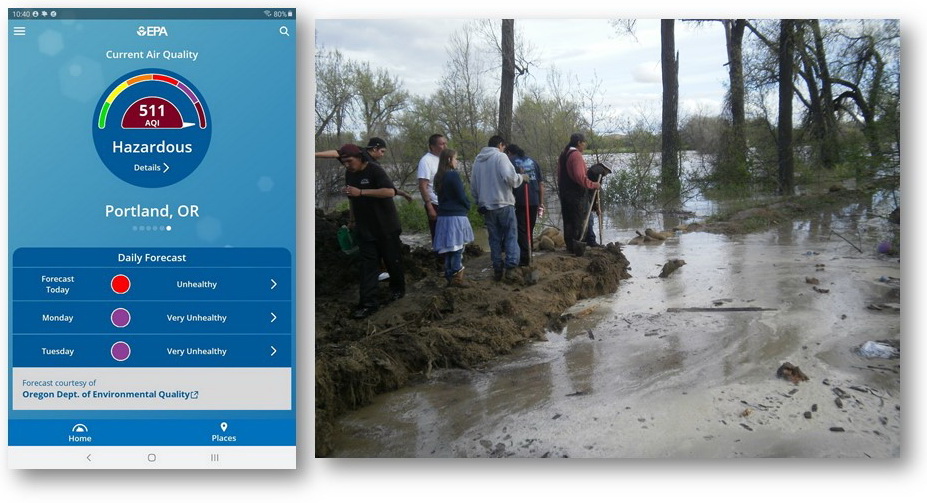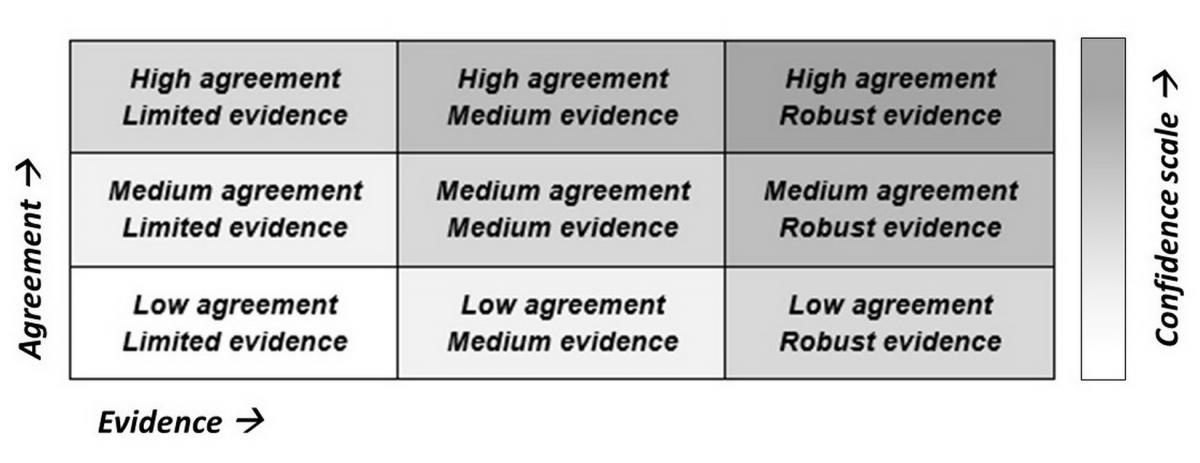
SUMMARY OF KEY MESSAGES AND RECOMMENDATIONS
During the preparation of Climate Change and Human Health in Montana, we developed key messages and recommendations about how climate change will impact the health of Montanans. Key messages refer to evidence-supported projections of those impacts. Recommendations are proposed behavioral and policy changes for coping with those impacts.
For each key message, we provide a statement of confidence in our findings. We rate the certainty of key messages based on agreement and evidence following the approach used by the Intergovernmental Panel on Climate Change’s (IPCC’s) Fifth Assessment Report (IPCC 2014) (Figure Key Messages-1).

For each key message, authors of the relevant section rate agreement—the consistency of the evidence among scientific reports—as “low,” “medium,” or “high.” Authors also rate the evidence as “limited,” “medium,” or “robust,” depending on the type, amount, and quality of the scientific information supporting the message. The authors offer their expert judgment in these assignments based on the level of evidence and agreement, and provide details in the text to support their ratings. The higher the level of author confidence in the key message, the greater the evidence and agreement.
This assessment draws from, and is an extension to, the 2017 Montana Climate Assessment (MCA) (Whitlock et al. 2017), which provides the first detailed analysis of expected impacts to Montana’s water, forests, and agriculture from climate change. MCA presents 35 key messages, seven of which serve as important foundations to the work of this report:
- Annual temperatures have risen 2-3oF (1.1-1.7oC) since 1950, and our growing season is now 12 days longer. Montana has experienced an increase in warm days and nights, both in summer and winter. There is no trend in precipitation since 1950. [high agreement, robust evidence]
- Climate models project that temperatures will continue to increase and by the end of the century average annual temperature may be 9.8oF (5.4oC) higher than those recorded between 1971-2000, given our present rate of greenhouse gas emissions. [high agreement, robust evidence]
- Precipitation received at a state level may increase slightly in the future, but these gains will be offset by evaporation and transpiration due to higher temperatures. More precipitation will be received in winter, spring, and fall; summers will become drier than at present. [moderate agreement, moderate evidence]
- Rising temperatures will result in a shift from snow to rain earlier in the year than at present. In turn, this shift will result in earlier dates for the onset of snowmelt and associated peak stream runoff by the end of the century. [high agreement, robust evidence]
- The number of days >90oF (>32oC) will increase significantly by the end of the century, with the greatest warming in eastern Montana. The eastern part of the state will also experience more extreme heat (i.e., days when the heat index[1] exceeds 105oF [41oC]). [high agreement, moderate evidence]
- Increased wildfires are expected as wetter springs result in increased fuel accumulation, and drier summers lead to fuel desiccation. The size of fires and the length of the fire season will increase in both forest and grassland. [high agreement, robust evidence]
- Unforeseen climate-related weather events will occur with projected increases in temperature and drought in the coming decades, including greater likelihood of spring flooding, severe summer drought, and extreme storm events. [high agreement, moderate evidence]
Following, then, is a summary of key messages and recommendations as developed in this report, Climate Change and Human Health in Montana.
Key Messages
- Three aspects of projected climate change are of greatest concern for human health in Montana: 1) increased summer temperatures and periods of extreme heat, with many days over 90oF (32oC); 2) reduced air quality from smoke, as wildfires will increase in size and frequency in the coming decades; and 3) more unexpected climate-related weather events (i.e., climate surprises), including rapid spring snowmelt and flooding, severe summer drought, and more extreme storms. [high agreement, robust evidence]
- The most vulnerable individuals to the combined effects of heat, smoke, and climate surprises will be those with existing chronic physical and mental health conditions, as well as individuals who are very young, very old, or pregnant. Montana’s at-risk populations include those exposed to prolonged heat and smoke, those living in poverty, having limited access to health services, and/or lacking adequate health insurance. [high agreement, robust evidence]
- Projected increased summer temperatures and wildfire occurrence will worsen heat- and smoke-related health problems such as respiratory and cardiopulmonary illness, and these potential problems are of most immediate concern. [high agreement, robust evidence]
- Earlier snowmelt, more intense precipitation events, and projected increases in floods will endanger lives and lead to more gastrointestinal disease due to contaminated water supplies, as well as increased opportunities for other water-borne, food-borne, and mold-related diseases. [high agreement, moderate evidence]
- Increased summer drought will likely increase cases of West Nile virus in Montana, but the impact of climate change on other vector-borne diseases is less clear. [high agreement, moderate evidence]
- Longer growing seasons, warmer temperatures and elevated carbon dioxide (CO2) levels are leading to increased pollen levels, worsening allergies and asthma. [high agreement, moderate evidence]
- Summer drought poses challenges to local agriculture, resulting in decreased food availability and nutritional quality, and to the safety and availability of public and private water supplies, especially for individuals and communities relying on surface water and shallow groundwater. [high agreement, robust evidence]
- Climate changes, acting alone or in combination, are reducing the availability of wild game, fish, and many subsistence, ceremonial, and medicinal plants, which threatens food security, community health, and cultural well-being, particularly for tribal communities. [high agreement, moderate evidence]
- Increased stress and increased mental illness are under recognized but serious health consequences of climate change. [high agreement, robust evidence]
Recommendations
- Address the health and economic impacts of climate change by creating an adequately funded and coordinated statewide public health network that engages public health and emergency and environmental management professionals, clinicians, climate scientists, elected leaders, and stakeholders in planning and implementing climate mitigation and adaptation strategies.
- Improve information collected and shared at the state and local levels on climate and health to facilitate this public health network and medical decision-making by:
- working with government agencies to expand heat, smoke, air-quality, and water-quality monitoring, and improve data accessibility, especially in underreported and underserved areas; and
- supporting efforts in the healthcare community to establish mechanisms for capturing and analyzing physical and mental health impacts related to heat, smoke and air quality, and water quality in Montana.
- Boost statewide technical expertise in implementing climate change adaptation by funding trainings for diverse stakeholders, landowners, professionals, and leadership.
- Continue the work of the MCA to update the information in this report and expand the understanding of climate change impacts on other sectors of importance in Montana.
- Get involved and be part of the solution! Use the information in this report to help yourself, your community, and Montana address climate change. Everyone has a role to play!
[1] A glossary is provided at the end of this report for unfamiliar terms. Heat index, for example, is defined in the glossary as a measure of perceived heat when humidity, which can make it feel much hotter, is factored in with the actual measured air temperature.
Literature Cited
[IPCC] Intergovernmental Panel on Climate Change. 2014. Climate change 2014: synthesis report: contribution of working groups I, II and III to the fifth assessment report of the Intergovernmental Panel on Climate Change. Pachauri RK, Meyer LA, eds. Geneva Switzerland: Intergovernmental Panel on Climate Change. 151 p.
Whitlock C, Cross W, Maxwell B, Silverman N, Wade AA. 2017. 2017 Montana Climate Assessment. Bozeman and Missoula MT: Montana State University and University of Montana, Montana Institute on Ecosystems. 318 p. Available online http://montanaclimate.org. Accessed 9 May 2020. doi:10.15788/m2ww82.
